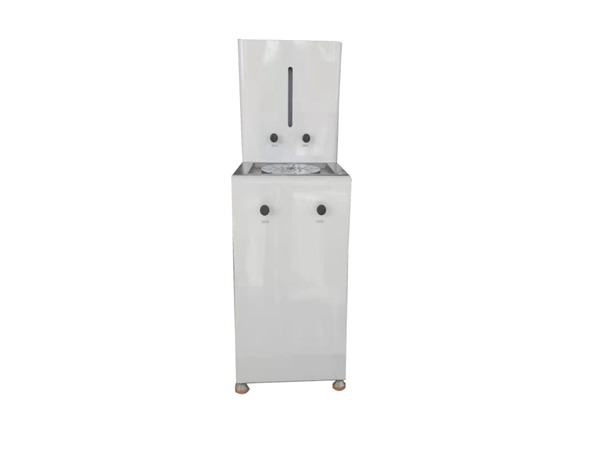
1、 Overview
Our company independently designs and produces various FM series universal water heating valve testing equipment. The FM-B valve testing equipment is a specialized testing equipment used in conjunction with pipe testing equipment, which has the advantages of small volume, simple and reasonable structure, and convenient operation.
2、 Purpose and Scope of Application
The FM-B valve testing equipment is suitable for flange type valves and internal thread type valves.
Testing of the following content:
1. Shell test;
2. Sealing test;
3. Upper sealing test: The equipment is suitable for testing medium: water.
3、 Structure
The detection equipment is mainly composed of
(1) Operating console; (2) Leakage testing cabinet; (3) Flange fixture; Test accessories and other components.
This equipment is used in conjunction with pressure resistant equipment for pipes
1. Operator console: According to national standards, the valve should not be subjected to external forces that may affect the test results during the testing process. Therefore, this test bench adopts a vertical installation of the test specimens. The two ports of the test piece are sealed separately, without any external force affecting the test results, making installation convenient and easy to operate.
2. Test cabinet: The test cabinet is mainly used for displaying the amount of leakage. The reading is obvious and intuitive.
4、 Configuration and parameter table
|
Number of test routes |
1 channel |
|
|
Flange base |
one |
|
|
Pipe diameter range |
Flange type |
Diameter DN=10~DN100 mm (1/2 "~4") |
|
Internal thread type |
Diameter DN=15~DN100 mm (1/2 "~4") |
|
|
Test fixture |
Flange type |
One set for DN10, 15, 20, 25, 32, 40, 50, 65, and 80100 each |
|
Internal thread type |
1/2〞,3/4〞,1〞,1¼〞,1½〞,2〞,2½〞,3〞,4〞One set each |
|
|
Pressure range |
PN=0~6MPa |
|
|
Leakage amount |
0~10ml |
|
|
Minimum graduation value |
0.1ml |
|
5、 Experimental project description
1. Test pressure
The calculated pressure that the inner cavity of the specimen should withstand during the test. The specific pressure value should be determined based on the nominal pressure index of the test piece and the corresponding national standards.
2. Shell test
For valves, it refers to the pressure test carried out on the entire valve casing formed by connecting the valve body and valve cover. The purpose is to test the compactness of the valve body and valve cover, as well as the pressure resistance of the entire shell, including the connection between the valve body and valve cover.
3. Sealing test
Test to verify the sealing performance of the opening and closing components and valve sealing pairs (see relevant standards for test pressure).
4. Upper sealing test
Test to verify the sealing performance of the valve stem and valve cover sealing pair.
6、 Operating procedures
Valves with a diameter ranging from DN10 to 100mm (1/2 "to 4") can be installed and tested on the control panel.
1. Installation of flange type valves
Fix the flange type testing tool (lower) and valve flange onto the operating table with bolts (sealing between flanges with O-ring seals). The upper part of the valve flange is tightened with testing aids (upper) through bolts (sealed with O-rings between the flanges). There is a quick change connector fixed in the middle of the upper auxiliary tool.
2. Installation of internal threaded valves
Fix the internal thread type valve testing aid (lower thread fixed on the operating table). Screw the valve directly onto the thread of the lower aid (sealing tape needs to be wrapped around the thread for sealing). Simply screw the accessory (upper) into the upper end of the valve. There is a quick change connector fixed in the middle of the upper auxiliary tool. After the tested valve is installed, insert the high-pressure hose into the quick change connector at the leakage detection inlet.
Connect the water pressure source to the main pressure inlet of the equipment through a high-pressure hose and open the pressure switch hand valve.
7、 Test methods and steps
Generally, sealing tests and shell tests are conducted first, followed by sealing tests
1. Upper sealing test
With the above pipelines and test pieces connected, the leakage detection switch is turned on. The leakage drainage switch is closed, and all other valves are in the open state.
At this time, loosen the packing gland of the test valve (if the valve is equipped with an upper sealing inspection device, and the performance of the upper sealing can be reliably checked without loosening the packing gland, then there is no need to loosen the packing gland). The tested valve is in a fully open state, causing the upper seal to close.
Start the pressure testing pump, and at this time, the pressure water passes through the main pressure inlet, the hand valve of the inlet pressure switch, the test piece, the high-pressure hose, the leakage detection inlet, the hand valve of the leakage detection switch, the leakage measuring tube, and the gas in the system is first discharged. When water is discharged from the leakage detection tube, turn off the leakage detection switch, gradually pressurize to the specified test pressure, and continue for a period of time (according to the standard specified time), then check the sealing performance.
2. Shell test
After the above test, release a portion of the pressure and tighten the packing gland to maintain the test pressure. The valve opening and closing parts are in a partially open state, gradually pressurized to the test pressure, and then the shell (including the packing box and the connection between the valve body and the valve cover) is inspected.
3 Sealing test
Firstly, put the pressure testing pump in low-pressure operation.
A. a Open the leakage detection switch manual valve to raise the liquid level of the leakage gauge to a certain height
B. b Close the opening and closing parts of the tested valve tightly (with normal force)
C. c Turn on the leakage drainage switch to keep the liquid level of the leakage measuring tube at a lower position. After the liquid level stabilizes, record the initial scale value of the liquid level.
D Apply pressure to the specified pressure, continue for a certain period of time (according to standard regulations), close the leakage drainage switch, and record the scale value of the leakage gauge at the time of termination.
8、 Evaluation indicators
1. The shell test, upper sealing test, and sealing test are all in accordance with the provisions of GB/T13927 standard.
2. Calculation of liquid leakage:
The leakage indication value of this testing equipment is 0.1ml per small cell. If the liquid level rises to n grids, the total leakage amount is: V=0.1xn (ml).
9、 Equipment maintenance and upkeep
This equipment belongs to non power source equipment, and the pressure water used for the equipment is provided by the pressure testing pump of the pipe testing equipment, so maintenance and upkeep are relatively simple.
1. Regularly inspect the valves and their connections of the equipment for water leakage. If there is any leakage, replace the sealing gasket in a timely manner.
2. Regularly keep the equipment clean and wipe off surface water accumulation (water leaked during testing).
3. The accumulated water in the water tank should be drained regularly, especially in winter, to prevent freezing and cracking of the water tank.
4. After the test is completed, the water inside the glass tube should be drained in a timely manner for the next test.




 Tel:15231476158
Tel:15231476158 Mailbox:948064885@qq.com
Mailbox:948064885@qq.com QQ:948064885
QQ:948064885 Add:Room 211, Juntai Fortune Plaza, Shuangtashan Town, Shuangluan District, Chengde City, Hebei Province
Add:Room 211, Juntai Fortune Plaza, Shuangtashan Town, Shuangluan District, Chengde City, Hebei Province


